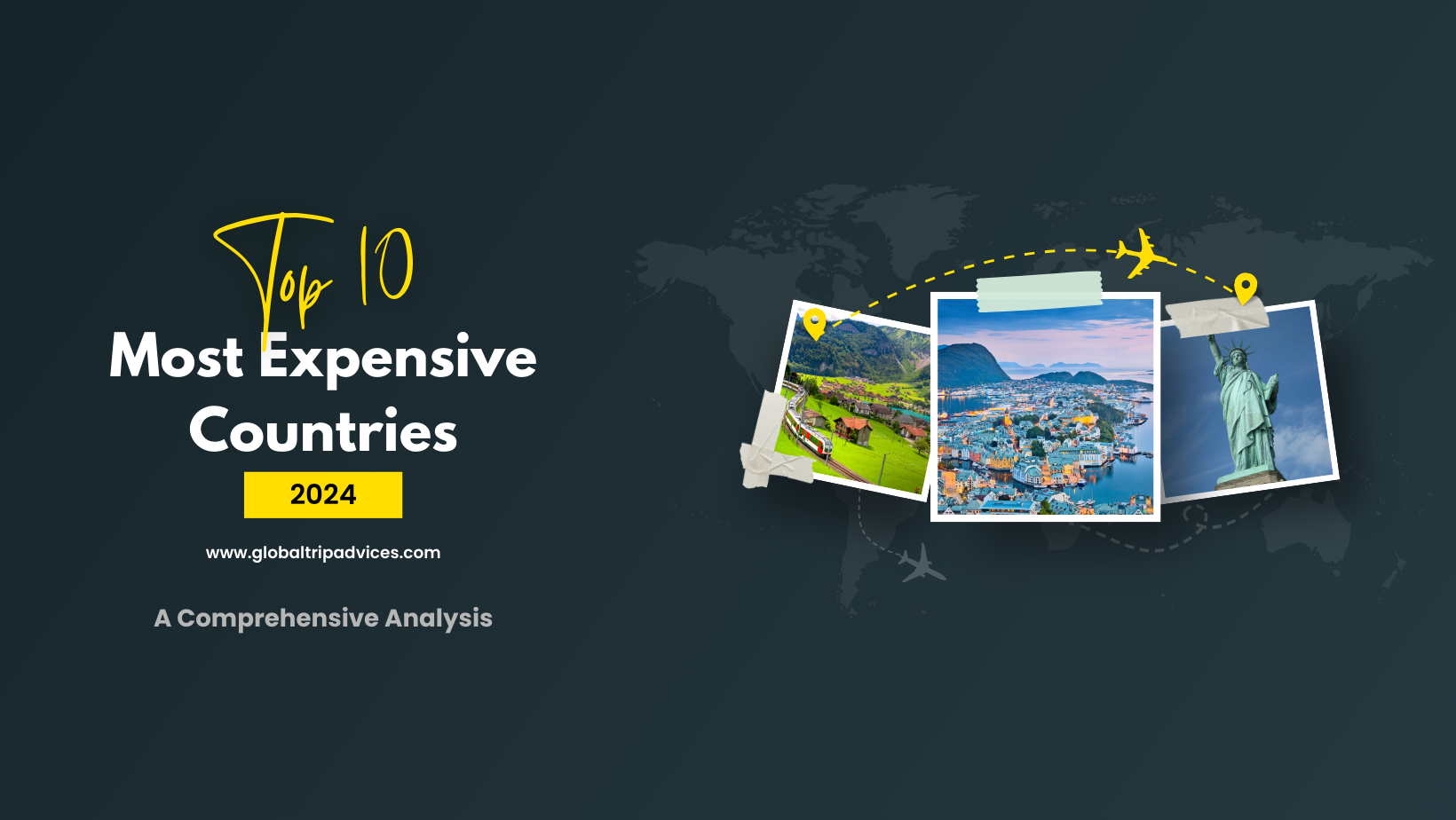In 2024, the global economy continues to face inflation, fluctuating currencies, and rising costs of living. As living standards improve in some nations, others experience price hikes due to demand for luxury goods, real estate booms, and tourism influxes. For anyone considering moving, visiting, or working abroad, understanding where the most expensive countries are and why they cost so much is crucial.
This article delves into the top 10 most expensive countries of 2024, breaking down factors such as living costs, expensive cities, and global price index comparisons.
1. Switzerland
Surprisingly, 2024 also did not see a drop in prices, so Switzerland remains one of the most highly-priced countries out there. Switzerland is famous for its high wages and quality of living and is blessed with a strong economy, which pushes up prices so very high. Current data also show that some Swiss cities, such as Zurich, Geneva, and Bern, are among the places with the highest cost of living; more specifically, the cost of housing, groceries, and healthcare in these cities is higher than in other global cities
Why It’s Expensive:
Currency: In the case of imports, they have high costs occasioned by the fact that the Swiss Franc or CHF is still among the strongest currencies in the world.
Healthcare & Education: The provision of quality health care and education is not cheap, branded it is.
Housing: Real estate costs are still exorbitant, and the only countries one can mention would be countries like Zurich.

2. Norway
Among this list of the most expensive countries, beautiful Norway boasts a highly developed social welfare system and an extended mass landscape. Housing costs, as well as the higher cost of services such as food and drink, make the leading Norwegian cities, such as Oslo and Bergen, expensive places to live.

Why It’s Expensive:
costsTaxes & Welfare: Norway has one of Europe’s most comprehensive state-funded social services, made possible by high taxes, but they result in high costs of goods and services.
Food Prices: Norway has relatively high food prices because a big portion of its food supply is imported.
Housing: The fee for acquiring or leasing real estate, especially in areas around large firms, is relatively high.
3. Iceland
Iceland is still a preferred tourist destination; therefore, prices here have increased. Almost everything is costly; Iceland is a small country with almost no export or production but an import-dependent nation. The most expensive city at present is the capital, Reykjavik.
result, High Wages: This is because the average income is high and with this, the people are able to buy more goods and services. Wang et al, as a result, the prices are pushed up.
Real Estate: The small dimension of Luxembourg and the economic development attained have brought to very high rates of living and particularly of renting or buying a house, particularly in the capital city.
Luxury Goods: Since the place attracts the rich, the prices for these products and services are quite expensive.

4. Luxembourg
In terms of living costs, Luxembourg is one of the richest countries in Europe in terms of per capita income. Luxembourg is famous for the banking and finance industries; however, it is also considered to be one of the countries with the highest prices for real estate in Europe.
Why It’s Expensive:
High Wages: This is because the average income is high, and with this, the people are able to buy more goods and services. Wang et al., as a result, the prices are pushed up.
Real Estate: The small dimension of Luxembourg and the economic development attained have brought to very high rates of living and particularly of renting or buying a house, particularly in the capital city.
Luxury Goods: Since the place attracts the rich, the prices for these products and services are quite expensive.

5. Singapore
Singapore is among the most wealthy nations in Asia and is among the most expensive cities globally to live in. It has a neat and clean environment with a high quality of life, making it a preference for most expatriates, thereby raising the cost of housing and other essentials.

Why It’s Expensive:
Real Estate: Affordable prices are ranked low in Singapore; the market for living spaces is expensive, in large part due to the lack of space for housing in the country.
Luxury Lifestyle: Singapore is home to a rather affluent crowd, and its food, shopping, and entertainment options can add up.
Imports: Singapore is a small island city, and as such, it has to import most of the products, which significantly affects the price.
6. Japan
There are few places in the world cheaper than Japan to travel; however, the costs of living in the country are significantly higher, especially in places like Tokyo and Osaka. High housing prices and a strong currency are the reasons why Japan is on this list.
Why It’s Expensive:
Housing: For instance, in developed cities such as Tokyo, property prices have increased, which has seen the increase in fees charged for rent.
Transportation: However, the transportation system in the country, though efficient, tends to be costly with reference to cross-country transportation.
Healthcare & Education: However, free basic health care to the citizens through the Ministry of Health is available, but other health and educational services geared towards the expatriates can at times be expensive.

7. Denmark
Denmark is a comfortable country to live in with a very good welfare state but a little expensive. In fact, with a staking of Copenhagen among the costly cities as regards the housing rates, Denmark is one of the most costly states in Europe.

Why It’s Expensive:
Taxation: This tax level contributes to the funding of social services in Denmark but makes the cost of most consumer items high.
Housing: Finally, it is important to make the note that the Danish real estate market, especially the housing market in Copenhagen, is considered to be pricey owing to high demand for limited supply.
Transportation: The poor consumers are charged relatively high fees to cover the cost of ensuring Denmark has among the best public transportation systems.
8. Australia
Australia is still relatively costly even with its large territories of land and booming market related to Sydney, Melbourne or any other city. The labour cost of the country is equally coupled with high cost of living, making the country among the most expensive to live in.
Why It’s Expensive:
Housing: Currently, Sydney and Melbourne have rated among the countries with the most expensive property prices.
Cost of Goods: Many products are imported in Australia because of geographic barriers, which affect their prices.
Healthcare: The publicly funded health care service in Australia is very good, but private health care costs a lot of money, especially for people not under public insurance.

9. United States
The United States continues to be a country of contrasts; for example, in the US you can pay much money for an apartment, for an apartment in New York, San Francisco, or Los Angeles. Inflation in these cities is hiked by high housing prices, health care facilities and luxury products

Why It’s Expensive:
Housing Costs: It is also worth mentioning that the prices for housing in such cities as New York and San Francisco, for instance, are some of the highest globally.
Healthcare: The United States of America has one of the highest healthcare costs in the world.
Income Inequality: Despite the existence of quite comfortable living conditions for many Americans, it leads to increased sales and prices in some sectors.
10. United Arab Emirates
The UAE as a nation, let alone Dubai and Abu Dhabi, has now been associated with luxury and wealth. These factors include improved economic activities, increased importation of goods and services, as well as an increase in the number of appeasing foreigners.
Why It’s Expensive:
Luxury Lifestyle: Expenses in luxury goods and services are inflated due to Dubai’s targeting of the high-end, wealthy tourist and expatriate market.
Imports: Like other countries in this list, the UAE relies on imports to feed it’s population and meet it’s consumer products, hence the high costs.
Real Estate: The high demand for high-end apartments and villas has led to this increase, especially in locations such as Dubai.

Global Living Costs: A Price Index Comparison
Price index mostly reflects the average cost of a certain basket of goods and services, so in case of the top ten countries, it is notably higher than in the rest of the world. For instance, Swiss health cost, relative to standards of living (captured by the price index), are almost double that of some countries in Eastern Europe or South America.
Here’s a breakdown of how these countries rank on various components of the price index:
- Housing Costs: The countries that leading in the international comparison of rent and property prices are Switzerland, Singapore, and the U.S.
- Groceries & Food: The countries with high food price are Norway, Iceland and Japan because they import most of their food.
- Luxury Goods & Services: The UAE and Singapore offer steep prices for high-end car imports, jewelry, and branded clothing and accessories.
Conclusion
Despite the fact that these countries provide the best opportunities as far as the overall quality of life, employment prospects, and richness of the community, they do have their costs. Whether it’s the expenditures of houses, the health care, or any other basic need consumer price, these nations are at the top of the world’s living expenses in 2024. People who plan to relocate or possibly explore these countries need to have adequate information in regard to the economic state of these countries for the purpose of financial planning.
Understanding what causes those costs to make those nations expensive will enable entire communities to prepare for some of the toughest tests they may face ‘in the sandbox’ of global costs.


